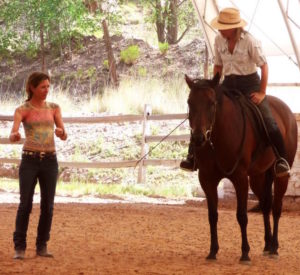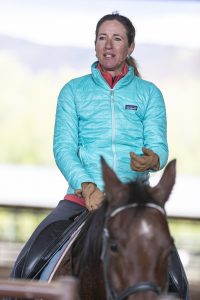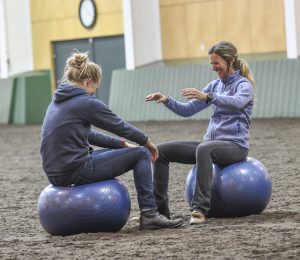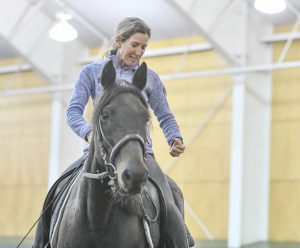Editor’s Note: Best Horse Practices Summit presenter Katrin Silva grew up riding dressage in Germany before moving to the United States at age 19 to learn to ride Western. She’s been riding both disciplines for the last 20 years and is a regular guest columnist for Cayuse Communications. The author of Dressage for All of Us: How to Help Any Horse Become a Happier, More Responsive Riding Partner lives in New Mexico where she works with dressage and Western clients. Visit her blog here.
On Inter-Being
The verb “to be” can be misleading, because we cannot “be” by ourselves, alone. “To be” is always to “inter-be.” If we combine the prefix “inter” with the verb “to be,” we have a new verb, “inter-be.” To inter-be and the action of interbeing reflects reality more accurately. We inter-are with one another and with all life.
Thich Nhat Hanh
Silva writes:

Silva teaches in and around Santa Fe, NM.
The idea that everything and everyone interconnects is as true in the horse world as anywhere else. Inter-being is even more obvious at the barn because horses are so sensitive to what goes on around them.
We, of course, inter-are with our horses. Whether we’re aware of it or not, our horse’s lives and our own lives influence each other on every level. Whenever we spend time with our horses, the horses remind us of our interconnectedness. They reflect our emotional equilibrium, or lack thereof. They feel our relaxed or tense state of mind, just as we feel theirs.
Riding a horse brilliantly illustrates the concept of inter-being. Horses and riders synchronize their body language, their emotional states, their moods, their anxieties. When things are going well, we make each other calmer, stronger, more confident, more mindful, more balanced. On a good day, we experience inter-being as that elusive quality of harmony between horse and rider.
But neither we nor our horses exist in a vacuum. If other people or situations leave us frazzled, frustrated, or overwhelmed, chances are we can’t inter-be with our horses in a positive way. They will, in turn, become just as frazzled, which will only frustrate us more.
 Inter-being means that everything we feel, say, and do has a ripple effect. If an argument with my significant other makes me angry, chances are I arrive at the barn in an unbalanced emotional state. If I then yell at my farrier, chances are he will not be as happy and calm in his work with my horse as he otherwise would. The horses he shoes will become stressed and tense, which will show in their work under saddle later that day. My clients will notice and blame themselves, or me, before they go home and spread their unhappiness to their families. My farrier may, if I really give him an earful, go on to his next job at another barn and arrive in a low mood, continuing the cycle.
Inter-being means that everything we feel, say, and do has a ripple effect. If an argument with my significant other makes me angry, chances are I arrive at the barn in an unbalanced emotional state. If I then yell at my farrier, chances are he will not be as happy and calm in his work with my horse as he otherwise would. The horses he shoes will become stressed and tense, which will show in their work under saddle later that day. My clients will notice and blame themselves, or me, before they go home and spread their unhappiness to their families. My farrier may, if I really give him an earful, go on to his next job at another barn and arrive in a low mood, continuing the cycle.
Calm and kindness radiate outward, from one horse-human encounter to another, from one part of our lives to the next. So does unkindness and tension. Even in times of social distancing, we do not live in isolation. We inter-are. This is not some vague, esoteric concept. Inter-being has concrete implications for horse people.

Katrin instructs a rider at the BHPS
For example, consider the hierarchy in certain stables, where the owners and trainers claim they want what is best for their horses, yet believe they are above grooms and barn workers. These people who keep the barns and horses in good order get little compensation or recognition for all they do, which leads to burnout and high turnover. Early in my horse career, I mucked stalls for sub-minimum wage, slept in tack rooms, worked seven days a week, and rode the second string of horses after all my other jobs were done. I felt invisible, exhausted, powerless, and depressed. I am sure the horses I took care of paid for my unhealthy emotional state.
If we truly want what’s best for our horses, we’ll treat anyone who feeds, grooms, or cleans stalls with consideration and respect. Why would we not value such important work?
The lines dividing experts from novices, professionals from amateurs, show riders from trail riders, or western riders from dressage riders are also a lot less clear-cut than most of us think they are. Rather than focus what divides us, we should take note that we’re all trying to build good relationships with our horses.

Katrin Silva at the 2019 Summit. Photo by Nina Fuller
We can embrace our inter-being, which will allow us to look for what we share, rather than for what we don’t. Rather than tear each other down, we can build each other up. My current working student may know less than I do about dressage, but she is an endurance rider who can teach me a lot about her corner of the equestrian universe. For example, I have been much more consistent about getting on and off the horses from both sides since we’ve been riding together.
Hurrying, stressing, raising our voices, or unkindness of any sort have no place around horses. A moment of anger can undo months or years of good training.
But if we are aware of our inter-being, we will be less inclined to blame and judge. Rather than pointing our fingers and rolling our eyes, we can create positive ripple effects. Everyone involved in our horses’ lives should treat them with respect and kindness. That happens more easily when we treat each other that way, too.
What a wonderful article. You are 100% correct in everything you said.
Thank you so much for sharing…..brilliant article.
Thank you, Lisa. It’s obvious when we think bout it.
What wonderful perspective–and obvious! I want to share it with all of my barn ‘family’. We have been going through some mighty and emotional discord at the barn and this article really speaks to what matters–our horses and their well being in the midst of such lack of harmony. Thank you–I always enjoy your writing!
I am almost never angry around my horses, because they make it so, thank God for that. However, I will carry esp. the last two paragraphs of Katrin’s writing here with me. Hurrying, raising our voices, feeling stressed etc, can be countered by my awareness that I can do the opposite, any time I want, simply by making it so. Leaving the annoying triggers behind, getting quiet, feeling my environment fully, and then engaging with my horses. And then let the ripple effect begin. Beautiful ….Thanks Katrin!